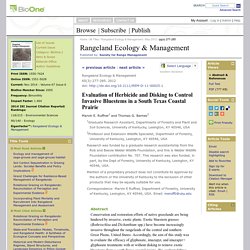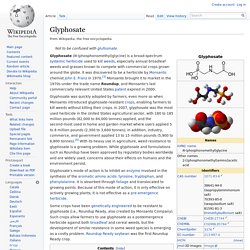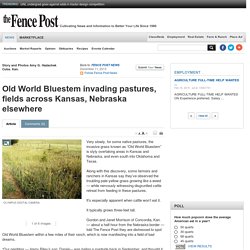

An Error Occurred Setting Your User Cookie. An Error Occurred Setting Your User Cookie. The University of Kansas. Art%253A10.1007%252Fs00572-011-0407-x.pdf?auth66=1425184514_3b2964b4aea0b8e933dff918fcfceb8f&ext= Art%253A10.1007%252Fs10530-006-9012-x.pdf?auth66=1425184439_3f4d63eb76b1f0b35d9e0918d37f1292&ext= Art%253A10.1007%252Fs10530-012-0174-4.pdf?auth66=1425184303_d983c3bf4066cbf1e2c8a60222efc943&ext= What are C3 and C4 Native Grass? The perennial grasses can be classified as either C3 or C4 plants.

These terms refer to the different pathways that plants use to capture carbon dioxide during photosynthesis. All species have the more primitive C3 pathway, but the additional C4 pathway evolved in species in the wet and dry tropics. The first product of carbon fixation in C3 plants involves a 3-carbon molecule, whilst C4 plants initially produce a 4-carbon molecule that then enters the C3 cycle.
Why are these differences important? These differences are important because the two pathways are also associated with different growth requirements. Alleopathic chemicals. What are C3 and C4 Native Grass? REM-D-11-00025. Annen, C.

A. 2008. Effects of tillage and growth regulator pretreatments on reed canarygrass (Phalaris arundinacea L.) control with sethoxydim. Natural Areas Journal 28:6–13. BioOne Annen, C. Americas_Grasslands_Conference_Proceedings_2013.pdf. Invasive Plant Species in Oklahoma Grasslands: Ecology, Management and Restoration - OKLAHOMA STATE UNIVERSITY. What are C3 and C4 Native Grass? Glyphosate. Glyphosate (N-(phosphonomethyl)glycine) is a broad-spectrum systemic herbicide used to kill weeds, especially annual broadleaf weeds and grasses known to compete with commercial crops grown around the globe.

It was discovered to be a herbicide by Monsanto chemist John E. Franz in 1970.[3] Monsanto brought it to market in the 1970s under the trade name Roundup, and Monsanto's last commercially relevant United States patent expired in 2000. Glyphosate was quickly adopted by farmers, even more so when Monsanto introduced glyphosate-resistant crops, enabling farmers to kill weeds without killing their crops. Glyphosate's mode of action is to inhibit an enzyme involved in the synthesis of the aromatic amino acids: tyrosine, tryptophan, and phenylalanine. It is absorbed through foliage and translocated to growing points. Gail_Wilson.pdf. Viewcontent.
Old World Bluestem invading pastures, fields across Kansas, Nebraska elsewhere. Very slowly, for some native pastures, the invasive grass known as “Old World Bluestem” is slyly overtaking areas in Kansas and Nebraska, and even south into Oklahoma and Texas.

Along with this discovery, some farmers and ranchers in Kansas say they’ve observed the troubling pale-yellow grass growing like a weed — while nervously witnessing disgruntled cattle retreat from feeding in these pastures. It’s especially apparent when cattle won’t eat it. It typically grows three-feet tall. Gordon and Janet Morrison of Concordia, Kan. — about a half-hour from the Nebraska border — told The Fence Post they are distressed to spot Old World Bluestem within a few miles of their ranch, which is now manifesting into a field of bad dreams. Fora09.pdf.